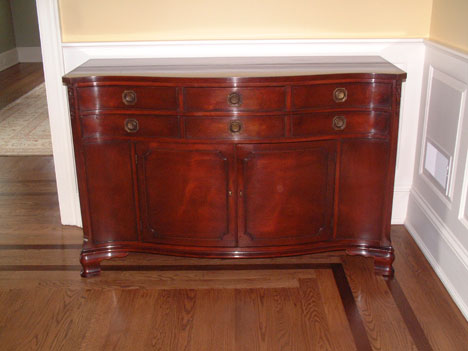
Since I built my home to be non-toxic, furnishing it has become a dilemma for me. Many of my own pieces are worn from my children using them as jungle gyms, and the color scheme of my new house is very different than my old house. I could buy furniture from companies that use woods from sustainable or managed forests, but they use solvent based finishes. I am uncomfortable about bring home a furniture piece with this type of finish since I do not know the long term effect on my family’s health from the off gassing of the chemicals from the piece.
Another option is to buy furniture from Furnature, who sell non-toxic upholstery or have pieces custom made, but the cost would be very expensive. A couch from Furnature could easily cost more than $3000.00. Over the last two years, I have become very resourceful in finding furniture that meets my non-toxic quest and my wallet. I have broken down my suggestions into a series of posts of which this is the first.
Antiques and Vintage Furniture, A Recycler’s dream
My fondest memories as I was growing up were in a house that was built in the 1920s. It was full of antiques, including a beloved grandfather clock, glass knobs, and beautiful wood trim and doors. We moved to Florida in my teens and my parents’ taste in furniture changed to more contemporary to fit the Florida lifestyle.
As I become an adult, I liked pieces that were light in color vowing to never buy dark, boring old traditional furniture. Not surprisingly, I built a house that echoes themes from my house that I grew up in. All of the sudden, old traditional furniture started to appeal to me and I started shopping at antiques stores.
My first acquired antique was a 1920s drum table with a top shaped in the form of a flower pedal with a green leather top. Since my purchase of my unusual drum table, I have become a 1920s through 1940s reproduction furniture shopper. The cost of reproduction furniture is very reasonable. After the war, there was a boom in furniture production so there are many reproduction pieces available. I shop at the local antique vendors and the local shows.
As a word of caution, ask if the piece has been touched up by the seller, or give it the smell test. Many antique dealers will refinish the pieces using the same solvent based nitrocellulose lacquers that they use on furniture today. If it smells, then most likely you smell the finishing products used by the dealers. Become friendly with some of the dealers and ask them if they find something that you like, to notify you before they repair it. I don’t mind a little nick or gouge in a piece of furniture because it gives it character.
Don’t miss the next instalment in this series on finding good used furniture, subscribe to this feed now.